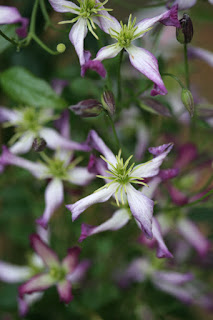All 3 groups like moisture rich soil and type 2 needs sunny positions type 1 and 3 are far more flexible. Many will grow in any aspect.
Group 1 are spring varieties and include montana, macropeta, alpini, cirrhosa and armandii. Some of these are evergreen and they flower early spring.
 |
| Clematis alpina 'Francis Rivers' |
Group 2 are the Nelly Moser types not all are large and fussy so its an unfair generalisation but there are a lot of elaborate flowers in this group, some very large,some double and some muti-pettled.
 |
| Clematis Daniel Derona |
Group 3 has many clematis in flower now. I also find it the most fun. There are many types in this group including viticella, texensis,terniflora, triternata,orientalis, repens, flammula and heradeleifolia. Some scramble up some spead out and some cover the ground and some are fragrant. A large proportion scramble up very successfully through bushes and trees and make them a perfect second flower on a shrub,hedge, tree or arbour that needs more interest or to compliment what is existing.
If you don't want the flowers to reach the heavens the following year its a good idea to cut the back to a couple of shoots in February. You can do this because they flower late. Remember the verse referring to the spring' ' If it flowers before June don't prune', should you prune in this instance you would be cutting the flowering shoots off but because these clematis flower late it is the idea time to chop.
Here are a few examples of type 3 clematis most can be seen scrambling through my garden.
Viticella
 | ||||||
| Clematis viticella 'Polish Spirit' |
 |
| Clematis purpurea 'Plena Elegans' (similar flower to 'Mary Rose') |
Viticellas are available in white, pinks,purples, blues and we have some multi petalled varies. Mary Rose is a mauve, lilac flower has been with us since the 1500. They are simply so great at bringing interest clour and flower to an otherwise dull area of the garden but they are not invasive or difficult and your free to cut them back and control how high you want them.
 |
| Betty Corning scrambling through the branches of my lime yellow Gledista Sunburst Tree. |
Orientalis
 |
Clematis orientalis ( tangutica) (Bill Mackenzie ) |
A very popular type 3 clematis often called the orange peal clematis and perhaps best grown against a wall.
Tritenata
 |
Flammula
Below the mass of little flowers on both tritenata and flamual clematis are scented.The tritenata at the top of the page is scambling sucessfully through a rose.
 | |
| Clematis flammula 'Sweet Sensation' |
 | |||||
| flammula scrambles throgh Lonicera Nitida hedge |
 |
This is Clematis Princess of Wales and I have included it because unlike the above it is ideal for scrambling along the ground. Grown very like a herbaceous perennial. More on late summer scrambling clematis >> |



